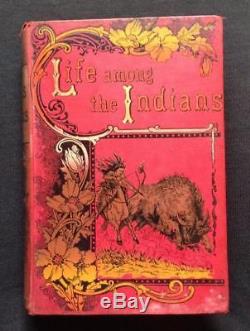
- Homepage
- Author
- Aleister Crowley (10)
- Anonymous (12)
- C H Spurgeon (10)
- Charles Dickens (25)
- Edgar Allan Poe (14)
- God (22)
- John Dee (21)
- L. Frank Baum (10)
- Lewis Carroll (41)
- Louisa May Alcott (10)
- Maria Parloa (9)
- Mark Twain (8)
- Mixed Authors (11)
- Multiple (8)
- Rudyard Kipling (26)
- Selected (8)
- Unknown (32)
- Various (41)
- Walter Scott (9)
- William Shakespeare (28)
- ... (5084)
- Binding
- Cloth (54)
- Cloth & Boards (2)
- Disbound (3)
- Fine Binding (204)
- Good (8)
- Hardback (115)
- Hardcover (1136)
- Hardcover / (4)
- Hardcover W / Jacket (3)
- Leather (506)
- Leather / Hardcover (4)
- Manuscript (26)
- Manuscript, Unbound (2)
- Original Copy (99)
- Paperback (7)
- Softcover (3)
- Softcover, Wraps (87)
- Spiral (2)
- Vellum (55)
- Very Good (2)
- ... (3117)
- Language
- Region
- Topic
- Year Printed
Rare George Catlin North American Indians Sioux Customs Tribes Hunting Antique



Hard cover with original bright red cloth with pictorial and decorated front board and spine. Good to Very Good condition. A bit of fading to bottom front edge. Undated with no edition details given.
Vii, 352 pages, Illustrated with engravings. 5.75 X 7.75 inches. See below for detailed contents and some of the wonderful illustrations within this amazing antique book. Hard cover with original bright.
Red cloth with pictorial and decorated front board and spine. Undated but circa 1870 with no edition details given. George Catlin was born in Wilkes-Barre, Pennsylvania. Following a brief career as a lawyer, he produced two major collections of paintings of American Indians and published a series of books chronicling his travels among the native peoples of North, Central and South America.
Catlin began his journey in 1830 when he accompanied General William Clark on a diplomatic mission up the Mississippi River into Native American territory. Louis became Catlin's base of operations for five trips he took between 1830 and 1836, eventually visiting fifty tribes. Two years later he ascended the Missouri River over 3000 km to Ft Union, where he spent several weeks among indigenous people still relatively untouched by European civilization. He visited eighteen tribes, including the Pawnee, Omaha, and Ponca in the south and the Mandan, Cheyenne, Crow, Assiniboine, and Blackfeet to the north. There, at the edge of the frontier, he produced the most vivid and penetrating portraits of his career. Later trips along the Arkansas, Red and Mississippi rivers as well as visits to Florida and the Great Lakes resulted in over 500 paintings and a substantial collection of artifacts.Catlin traveled with his Indian Gallery to major cities such as Pittsburgh, Cincinnati, and New York. He hung his paintings "salon style"-side by side and one above another-to great effect.
Visitors identified each painting by the number on the frame as listed in Catlin's catalogue. Soon afterwards he began a lifelong effort to sell his collection to the U.
Catlin the showman and entrepreneur initially attracted crowds to his Indian Gallery in London, Brussels, and Paris. The French critic Charles Baudelaire remarked on Catlin's paintings, M. Catlin has captured the proud, free character and noble expression of these splendid fellows in a masterly way. Catlin's dream was to sell his Indian Gallery to the U. Government so that his life's work would be preserved intact. His continued attempts to persuade various officials in Washington, D. He was forced to sell the original Indian Gallery, now 607 paintings, due to personal debts in 1852. Industrialist Joseph Harrison took possession of the paintings and artifacts, which he stored in a factory in Philadelphia, as security. Catlin spent the last 20 years of his life trying to re-create his collection. This second collection of paintings is known as the "Cartoon Collection" since the works are based on the outlines he drew of the works from the 1830s.Three years later he published 25 plates, entitled Catlin's North American Indian Portfolio, and, in 1848, Eight Years' Travels and Residence in Europe. The record of these later years is contained in Last Rambles amongst the Indians of the Rocky Mountains and the Andes (1868) and My Life among the Indians ed. In 1872, Catlin traveled to Washington, D. At the invitation of Joseph Henry, the first secretary of the Smithsonian. Until his death later that year in Jersey City, New Jersey, Catlin worked in a studio in the Smithsonian Castle.
Harrison's widow donated the original Indian Gallery-more than 500 works-to the Smithsonian in 1879. The nearly complete surviving set of Catlin's first Indian Gallery painted in the 1830s is now part of the Smithsonian American Art Museum's collection. Some 700 sketches are in the American Museum of Natural History, New York City.
The accuracy of some of Catlin's observations has been questioned. He claimed to be the first white man to see the Minnesota pipestone quarries, and pipestone was named catlinite.
Catlin exaggerated various features of the site, and his boastful account of his visit aroused his critics, who disputed his claim of being the first white man to investigate the quarry. Previous recorded white visitors include the Groselliers and Radisson, Father Louis Hennepin, Baron LaHonton and others. Lewis and Clark noted the pipestone quarry in their journals in 1805.
Fur trader Philander Prescott had written another account of the area in 1831. Get Supersized Images & Free Image Hosting.
Attention Sellers - Get Templates Image Hosting, Scheduling at Auctiva. The item "RARE GEORGE CATLIN NORTH AMERICAN INDIANS SIOUX CUSTOMS TRIBES HUNTING ANTIQUE" is in sale since Tuesday, July 10, 2018. This item is in the category "Books\Antiquarian & Collectible". The seller is "vintage_antiques_2018" and is located in USA.
This item can be shipped to North, South, or Latin America, all countries in Europe, all countries in continental Asia, Australia.
- Year Printed: 1870
- Special Attributes: Illustrated

